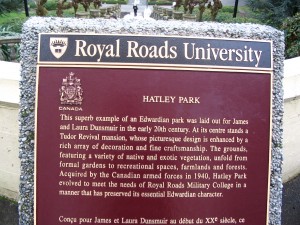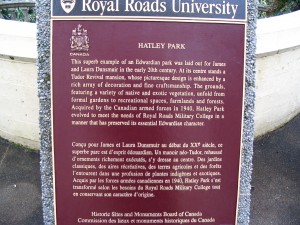
Two Naval Colleges in Canada? Yes, there were! Let me tell you about them….
By: RCNC #247 R.A.F. Montgomery
1. Royal Naval College of Canada (RNCC) – 1911 to 1922
In 1911 LCdr. E.A. Nixon, Royal Navy (RN), aided by a staff of 12, established RNCC in the dockyard at Halifax. Captain (N) E.H. Martin, RN, was in command and was also in command of HMC Dockyard.
When the call for Cadets went out in 1911, twenty young men aged 14 years responded. By January, 1914, the numbers applying had dwindled, which prompted a bill in the House of Commons in Ottawa to close RNCC. This bill was vigorously opposed by the Minister of Marine and was not passed, in part because Canada entered the First World War in August, 1914.
For the next 3 years the College enjoyed a large measure of success. In 1917 the Minister of Marine declared that the College had had its best year, with an enrolment of Cadets from Dawson City to the Maritimes.
On 6 December 1917 at 0845, the French munitions ship, Mont Blanc, collided in Halifax Harbour with the Belgian relief ship, Ilmo. The Mont Blanc burst into flames and exploded 20 minutes later. The College was destroyed, along with much of Halifax and Dartmouth.
What could be salvaged was moved to the Royal Military College (RMC) in Kingston. The Naval Cadets were warmly welcomed at RMC, which established RNCC in the building known as HMCS Stone Frigate.
By mid-1918 it became apparent that due to irreconcilable differences the existence of the two Colleges could not exist on the same site. One of the many reasons for this was the age differential between the Naval Cadets and the older Army Cadets at RMC.
The question of funding RNCC became an issue in Parliament. While Parliament quibbled, RNCC took up another abode in 1919 in a long brick building used as a drill deck in the naval dockyard at Esquimault. RNCC continued at this site until 1922, when it was closed by a decision made in the House of Commons.
2. Royal Canadian Naval College (RCNC) – 1942 to 1947
In 1940 the Royal Canadian Navy (RCN) acquired Hatley Park (west of Victoria) from the Dunsmuir Estate for the sum of $75,000.00, which was the same amount spent in 1908 to erect a wrought-iron-on-stone-base fence on 3 sides of the 565-acre property. The south side, which faces the Straits of Juan de Fuca and the Olympic mountains in the State of Washington, required no fencing.
In 1941 and early 1942 this site, commissioned as HMCS Royal Roads, was used by the RCN to train 5 classes of RCNVR officers, each with 100 Acting Sub-Lieutenants. This was similar to the 90 day training scheme at HMCS Kings in Halifax.
A decision was taken in late 1941 to phase out the Sub-Lieutenant Officer training at HMCS Royal Roads and to establish a Naval College which would open in September, 1942. At about the same time, the Defence Department in Ottawa decided to close RMC in June, 1942. Thus from the fall of 1942 to July 1947, the only Armed Forces Cadet College open in Canada was RCNC at HMCS Royal Roads.
Captain (N) J.M. Grant was appointed the Captain of HMCS Royal Roads and was in command of RCNC. The Director of Studies was Cdr. K.G.B. Ketchum, who had been a graduate in 1921 of RNCC. At the time of his appointment in 1942 he was the Headmaster of St. Andrew’s College in Aurora, Ontario. By the summer of 1942 some academic instructors in the rank of Major at RMC arrived at RCNC and became Lieutenant Commanders RCN. The official opening of RCNC was on 21 October 1942 in celebration of Trafalgar Day.
A recruiting campaign to attract 100 Naval Cadets was conducted in the fall and winter of 1941-1942. For the first year, commencing in September 1942, 50 cadets aged 18 with senior matriculation (Grade 13) in Ontario or equivalent for those from other provinces were taken for a one-year course. The balance of 50 cadets aged 17 with junior matriculation (Grade 12) in Ontario or equivalent were taken for a two-year course. In subsequent years, classes of about 55 Naval Cadets aged 17 were recruited for a two-year course which covered both academic subjects and professional naval subjects. The course year for each of the two years commenced about mid-August and ran to the following first week in July. Upon graduation as Midshipmen, each person had the option to elect RCN or RCN(R), and had achieved academically the equivalent of first-year engineering at any university in Canada.
In the summer of 1947 the Royal Canadian Air Force became a partner in the college life at HMCS Royal Roads, and the college name was changed to the RCN-RCAF College at HMCS Royal Roads. This name lasted for one year, after which it became a tri-service college in the fall of 1948 with the name of CANSERVCOL ROYAL ROADS. At the same time, RMC reopened under the name of CANSERVCOL RMC.
The number of Naval Cadets who entered RCNC during its life totalled about 345. Once CANSERVCOL ROYAL ROADS was established, the Stone Frigate HMCS Royal Roads was paid off.
R.A.F. Montgomery
The author (RCNC #247) was in the RCNC class of 1945-1947. At the time of his graduation in July 1947 he was the Chief Cadet Captain.
Footnote: Setting the record straight.
It is clear to me from the historical evidence I have found, that Royal Roads opened as a tri-service college in September 1948 under the name CANSERVCOL ROYAL ROADS. This name remained until 1968 when it was changed to Royal Roads Military College (RRMC). My interest in this subject is to achieve historical accuracy – not to act on the whims of revisionist historians who don’t know the facts.
An example of revisionism is found on the plaque at the head of Neptune Steps (see 2 photos above, which I took in 2007). This plaque was erected by the Historic Sites and Monuments Board of Canada (Monuments Board) after 1995. The plaque refers to the acquisition “…by the Canadian armed forces in 1940,…”. The name Canadian Armed Forces did not exist until 1968 when the Canadian Forces Reorganization Act came into effect, which is the same year as the name RRMC came into effect. In 1940 it was the Royal Canadian Navy (RCN), through the Government of Canada, which acquired Hatley Park and ran it for 7 years as an Naval Establishment. Why wasn’t recognition given to the RCN by the Monuments Board? I have tried to change the wording on the plaque without success.
A picture of a stained glass window dated 1948 for RRMC, the fact is (and I repeat) the name ROYAL ROADS MILITARY COLLEGE was not used until 1968. When was this stained glass window installed and where? In my opinion there has been a concerted attempt to refer to Royal Roads from 1940 to 1995 as RRMC. This was evident in May 1995 at the closing of RRMC (which I attended), when clothing and other artifacts for sale had the inscription RRMC 1940 to 1995 embroidered or engraved on them.
R.A.F. Montgomery





